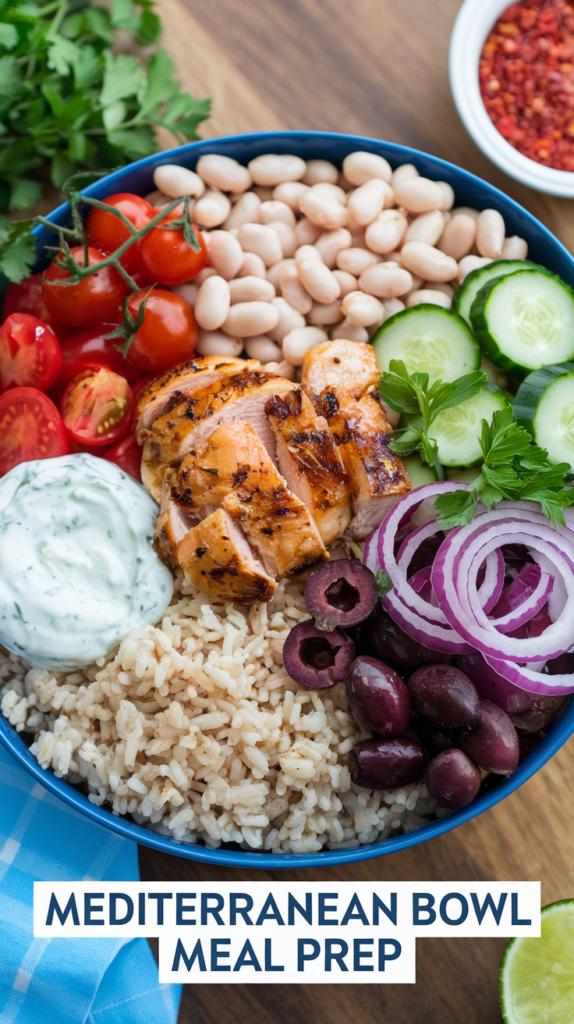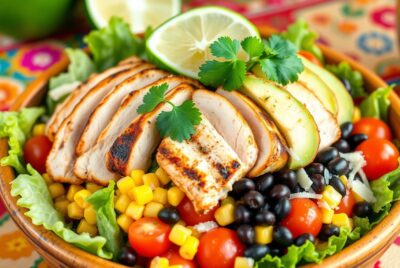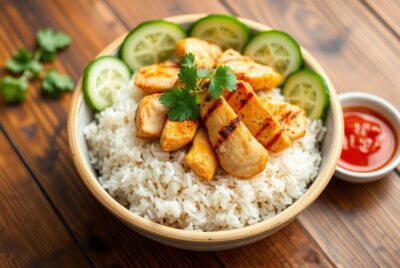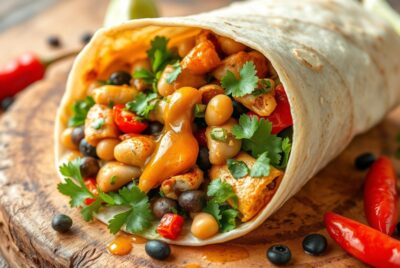Savor the Mediterranean in a Delightful Bowl
The concept of a Mediterranean Bowl captures the essence of vibrant flavors and fresh ingredients that define Mediterranean cuisine. As I explore these delightful bowls, I’m reminded of the healthy meals that utilize wholesome ingredients, creating flavorful bowls that satisfy the palate and nourish the body. The Mediterranean diet is not just a trend; it’s a lifestyle choice known for its numerous health benefits. Join me on a culinary journey where we delve into how to create the perfect Mediterranean Bowl, celebrating the variety and richness of this incredible cuisine.
What is a Mediterranean Bowl?
A Mediterranean Bowl is a vibrant and satisfying dish that features an array of fresh and wholesome ingredients, reflecting the essence of Mediterranean cuisine. This bowl combines various components, prioritizing fresh produce, whole grains, legumes, and healthy fats. It represents the definition of Mediterranean Bowl as a colorful and nutritious meal option that caters to various dietary preferences.
Key Ingredients in a Mediterranean Bowl
When constructing a Mediterranean Bowl, I always start with key Mediterranean ingredients that contribute to both flavor and nutritional value. Common staples include:
- Olives
- Feta cheese
- Chickpeas
- Quinoa
- Couscous
- Fresh vegetables like cucumbers, tomatoes, and bell peppers
- Herbs such as parsley and basil
These ingredients combine beautifully to create a meal that’s not only visually appealing but also rich in essential nutrients.
Health Benefits of Mediterranean Cuisine
There are numerous health benefits associated with Mediterranean cuisine, making it a popular choice for anyone aiming for nutritious meals. Studies suggest that following a Mediterranean diet can positively impact heart health, assist with weight management, and promote overall well-being. The diet’s emphasis on healthy fats from olive oil and nuts, along with plenty of fruits and vegetables, contributes significantly to these health benefits.
Popular Mediterranean Bowl Combinations
Exploring popular Mediterranean Bowl combinations opens a delightful culinary journey. Each bowl reflects the region’s diversity and rich flavors, perfect for any occasion. I want to share some of my favorite combinations, showcasing their unique attributes and deliciousness.
Classic Hummus and Pita Bowl
The Classic Hummus and Pita Bowl stands out as a favorite among many. I love to start with a generous scoop of creamy hummus, which serves as a fantastic base. Fresh vegetables such as cucumbers, cherry tomatoes, and bell peppers add a vibrant crunch, while warm pita bread completes the experience. This dish is perfect for those seeking a light and refreshing option, making it one of the treasured Mediterranean Bowl recipes.
Quinoa Tabbouleh Bowl
Next on my list is the Quinoa Tabbouleh Bowl. This dish highlights tabbouleh recipes filled with vibrant herbs, including parsley and mint, along with fresh tomatoes and cucumber. The addition of quinoa offers a delightful twist, bringing a nutty flavor and protein punch. Drizzled with lemon juice and olive oil, this bowl encapsulates the essence of Mediterranean freshness, making it truly unforgettable.
Grilled Chicken and Vegetable Bowl
For those craving something heartier, the Grilled Chicken and Vegetable Bowl is a must-try. Marinated chicken, kissed by the grill, pairs beautifully with a medley of roasted vegetables such as zucchini, eggplant, and bell peppers. The combination of savory and smoky flavors creates a satisfying experience, exemplifying some of the most cherished Mediterranean Bowl recipes. I can hardly resist a well-assembled bowl packed with nutrients and taste.
How to Customize Your Mediterranean Bowl
Creating a Mediterranean Bowl that suits my personal taste is a delightful adventure. I can easily customize a Mediterranean Bowl to align with my dietary preferences. Whether I identify as a vegan or simply enjoy a hearty meal filled with various flavors and textures, there are countless ways to achieve my desired bowl perfection.
Vegan and Vegetarian Options
For those exploring vegan options, I can load my bowl with nutrient-dense ingredients. Lentils, chickpeas, and quinoa serve as excellent bases packed with fiber and protein. I can always add a rainbow of vegetables, like roasted bell peppers, vibrant cherry tomatoes, and crunchy cucumbers. Fresh herbs such as parsley or mint will enhance the flavor, making my Mediterranean Bowl not just healthy, but also incredibly tasty.
Protein Choices for Every Diet
Flexibility in protein sources allows everyone to enjoy these bowls. For me, grilled chicken or lamb can add a savory touch, while my vegetarian friends might prefer roasted tofu or chickpeas for their protein fix. Nuts and seeds, such as almonds or pumpkin seeds, can offer crunch and nutritional benefits. With various choices available, I can craft a bespoke Mediterranean Bowl that satisfies both protein lovers and plant-based eaters alike.
Perfect Dressings for Mediterranean Bowls
Dressings can truly elevate a Mediterranean Bowl, transforming simple ingredients into a vibrant dish bursting with flavor. I love experimenting with different Mediterranean dressings, especially tahini sauce and lemon-olive oil dressings. Here, I’ll share my favorite recipes that enhance flavors and bring my Mediterranean bowls to life.
Tahini Sauce Recipes
Tahini sauce is a creamy, nutty dressing that pairs perfectly with various bowls. It not only adds richness but also complements the fresh ingredients typical of Mediterranean cuisine. Here are some delightful variations of tahini sauce that I often prepare:
- Classic Tahini Sauce: Combine 1 cup of tahini, juice of 1 lemon, 2 cloves of minced garlic, and a pinch of salt. Mix with water until you reach your desired consistency.
- Spicy Tahini Sauce: Add a teaspoon of cayenne pepper or chili paste to the classic tahini sauce for a kick of heat.
- Cilantro Tahini Sauce: Blend in a handful of fresh cilantro and a splash of lime juice for a fresh twist.
Lemon-Olive Oil Dressing
This dressing is incredibly simple yet effective. Combining the zest and juice of a lemon with high-quality extra virgin olive oil creates a lemon dressing that brightens up any dish. I often add a pinch of salt and pepper to enhance the taste further. This dressing provides balanced acidity and richness, making it an essential for enhancing flavors in my Mediterranean bowls.
Tips for Assembling Your Mediterranean Bowl
Creating the perfect Mediterranean bowl is an art that requires careful attention to detail. I have gathered some practical bowl assembly tips to help you craft a dish that’s not only delicious but also visually appealing. Flavor layering plays a critical role in ensuring each bite offers a delightful explosion of tastes and textures. Selecting the right bowl can elevate the presentation, making your meal even more enticing.
Layering Techniques for Flavor
Effective flavor layering enhances the dining experience by combining different textures and flavors. To achieve this, consider the following:
- Start with a hearty base such as quinoa or brown rice to absorb flavors.
- Add creamy elements like hummus or tzatziki next for a satisfying texture.
- Incorporate crunchy toppings such as fresh vegetables or nuts for contrast.
- Finish with a sprinkle of fresh herbs like parsley or mint for a burst of freshness.
Choosing the Right Bowl
The optimal bowl selection can greatly enhance the presentation of your meal. Here are some thoughtful considerations:
| Material | Benefits | Best for |
|---|---|---|
| Ceramic | Retains heat, attractive designs | Hot dishes |
| Glass | Showcases layers, easy to clean | Cold dishes |
| Bamboo | Eco-friendly, lightweight | Casual dining |
| Stainless Steel | Durable, non-reactive | Outdoor meals |
By integrating these bowl assembly tips and employing strategic flavor layering, I can ensure that each Mediterranean bowl I create offers a quality dining experience. The right bowl selection complements the presentation, transforming a simple meal into an inviting feast that delights the senses.
Meal Prep Ideas for Mediterranean Bowls
Preparing Mediterranean bowls in advance can lighten my week and create delicious, nutritious meals. With the right approach to meal prep Mediterranean techniques, I can save time and enjoy fresh flavors every day. Making make-ahead bowls with pre-cooked ingredients ensures convenient meals ready for any occasion.
Making Bowls Ahead of Time
To streamline the meal prep process, I find it effective to cook large batches of grains, proteins, and vegetables. Using this strategy allows me to mix and match components throughout the week. Here’s how I do it:
- Cook a variety of grains such as quinoa, farro, or brown rice.
- Prepare proteins like grilled chicken, roasted chickpeas, or baked falafel.
- Roast a selection of vegetables, including bell peppers, zucchini, and sweet potatoes.
- Assemble the make-ahead bowls in airtight containers for easy access.
Storage Tips for Fresh Ingredients
Proper ingredient storage is crucial to maintain freshness in my Mediterranean meal prep. Here are some tips I follow:
- Use airtight containers to keep grains and proteins from drying out.
- Store chopped vegetables in water to keep them crisp longer.
- Label containers with dates to track freshness and usage.
- Place herbs like parsley or basil in a glass of water in the fridge to extend their shelf life.
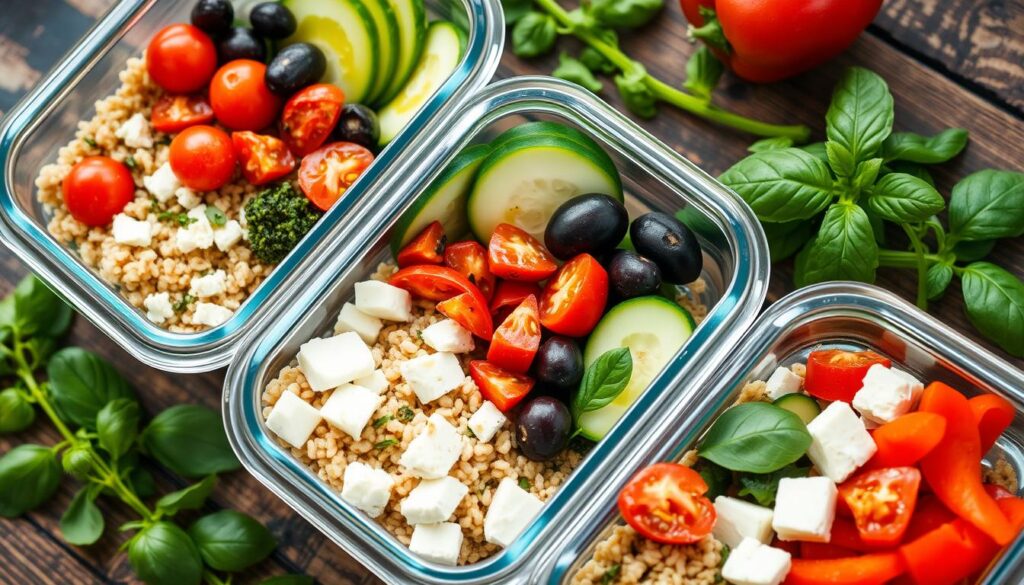
Serving Suggestions and Pairings
Enhancing the experience of serving Mediterranean Bowls can be achieved through thoughtful accompaniments and beverage pairings. These elements not only add depth to the meal but also celebrate the vibrant flavors characteristic of Mediterranean cuisine.
Accompaniments for Mediterranean Bowls
To elevate the enjoyment of Mediterranean Bowls, consider these delightful accompaniments that will complement your main dish:
- Stuffed grape leaves
- Classic Greek salad
- Roasted red pepper dip
- Pita bread with tzatziki
Each of these small bites can serve as meal enhancements, adding texture and richness to the overall dining experience.
Wine and Beverage Pairings
Selecting the right beverages can intensify the flavors in Mediterranean Bowls. Here are some outstanding wine pairings and drinks to consider:
| Bowl Type | Recommended Wine | Alternative Beverage |
|---|---|---|
| Grilled Chicken Bowl | Sauvignon Blanc | Sparkling water with lemon |
| Quinoa Tabbouleh Bowl | Pinot Grigio | Mint iced tea |
| Classic Hummus Bowl | Rosé | Fresh lemonade |
These wine pairings are ideal for accentuating the flavors present in the bowls, ensuring a perfect harmony between food and drink.
Exploring Regional Variations of Mediterranean Bowls
The Mediterranean region is rich in diverse cultures, each contributing unique flavors to the culinary landscape. Exploring regional Mediterranean dishes, one can appreciate how Greek bowls and Lebanese cuisine showcase distinct flavor variations that tantalize the taste buds. Let’s delve deeper into these culinary treasures.
Greek-Inspired Bowls
When I think about Greek-inspired bowls, my mind instantly drifts to fresh, vibrant ingredients. Traditional components like tzatziki, feta cheese, and olives create the foundation of these delightful creations. Incorporating grilled meats, such as lamb or chicken, along with crisp vegetables like cucumbers and tomatoes, elevates the experience. Additions such as chickpeas or a drizzle of olive oil bring authenticity to a classic Greek bowl.
Lebanese Flavor Profiles
On the other hand, Lebanese cuisine introduces a flavor profile that is equally enthralling. The use of spices, especially za’atar and sumac, transforms an ordinary bowl into a feast of aroma and taste. Ingredients such as grilled kebabs, roasted eggplant, and a colorful array of pickled vegetables contribute to the overall experience. Whether I opt for tabbouleh or a chickpea salad, the freshness in Lebanese cuisine always stands out.
| Elements | Greek Bowls | Lebanese Cuisine |
|---|---|---|
| Main Ingredients | Feta, Olives, Tzatziki | Za’atar, Sumac, Tahini |
| Textures | Crunchy and Creamy | Roasted and Fresh |
| Protein Choices | Lamb, Chicken, Chickpeas | Kebabs, Lentils, Grilled Vegetables |
| Notable Dishes | Greek Salad, Gyro Bowl | Tabbouleh, Fattoush |
Embracing the variety found in regional Mediterranean dishes opens up a world of flavors, each inspired by the rich history and culture of its origin. Whether I’m relishing a Greek bowl or indulging in Lebanese cuisine, the diverse flavor variations make every meal a celebration of this vibrant region.
The Rise of Mediterranean Bowls in Culinary Trends
The Mediterranean trend has seen a remarkable surge in popularity within culinary circles. People are increasingly drawn to the health benefits and vibrant flavors derived from this cuisine. The appeal of Mediterranean bowls stems from their ability to combine fresh, wholesome ingredients that cater to various dietary preferences.
Why They Are So Popular Today
Health trends emphasizing whole foods and plant-based eating are a significant factor in the popularity of Mediterranean bowls. These dishes typically feature nutrient-rich ingredients such as legumes, grains, and colorful vegetables. As more individuals seek healthier lifestyle choices, this type of cuisine resonates well. The convenience of customizability allows everyone to create a dish that aligns with their personal tastes and nutritional needs.
Influences in Modern Cuisine
Chefs worldwide are increasingly incorporating Mediterranean culinary influences into modern dishes. This integration manifests itself in various ways, from restaurant menus to home-cooked meals. Techniques and flavors originating from Mediterranean regions enhance the culinary landscape, making it more diverse and appealing. Ingredients like olive oil, fresh herbs, and spices have become staples, reflecting their influence on contemporary cooking styles.
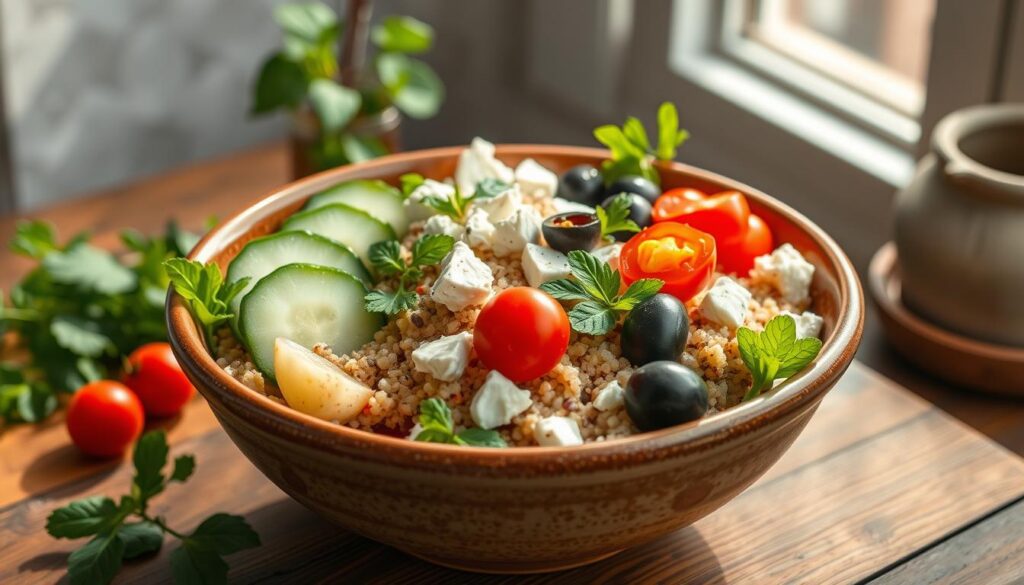
| Aspect | Traditional Mediterranean Bowls | Modern Interpretations |
|---|---|---|
| Ingredients | Legumes, grains, fresh veggies | Quinoa, kale, exotic spices |
| Presentation | Classic, rustic style | Artistic plating, vibrant colors |
| Flavor Profiles | Simple, bold flavors | Complex flavor combinations |
| Dietary Considerations | Oils and fats | Plant-based, gluten-free options |
Hosting a Mediterranean Bowl Party
Bringing the vibrant flavors of the Mediterranean to your gathering can create an unforgettable experience for your guests. Hosting a Mediterranean party with a DIY bowl bar will not only tantalize taste buds but also encourage interaction and creativity. Here, I’ll share ideas for creating a festive atmosphere and suggest some delightful sample menus and recipes that can make your event a culinary success.
Ideas for a DIY Bowl Bar
Setting up a DIY bowl bar allows guests to customize their bowls according to their preferences, making it a perfect fit for any crowd. Here are some entertaining ideas to consider:
- Base Choices: Offer a variety of base options such as quinoa, brown rice, or traditional couscous.
- Protein Selections: Include grilled chicken, falafel, shrimp, or roasted chickpeas to cater to both meat lovers and vegetarians.
- Veggies Galore: Present an array of fresh veggies like cherry tomatoes, cucumbers, bell peppers, and red onions.
- Flavor Boosters: Enhance bowls with toppings such as feta cheese, olives, or pickled vegetables.
- Dressing Station: Create a selection of dressings like tahini, lemon-olive oil, and yogurt sauce for that Mediterranean flair.
Sample Menus and Recipes
Your Mediterranean bowl party can feature varied sample menus that appeal to different palates. Consider the following menu ideas:
| Menu Item | Description |
|---|---|
| Classic Greek Bowl | A perfect blend of quinoa, grilled chicken, tzatziki, cucumbers, and feta cheese. |
| Veggie Delight Bowl | Loaded with roasted veggies, hummus, and a sprinkle of pine nuts over a bed of couscous. |
| Seafood Bowl | Includes lemon-herb shrimp, avocado, mixed greens, and a drizzle of garlic sauce. |
| Mediterranean Mezze Bowl | A mix of falafel, baba ghanoush, olives, and fresh pita bread for dipping. |
By combining these entertaining ideas with delicious sample menus, your Mediterranean bowl party will be a delightful celebration of taste and togetherness. Encourage your guests to mix, match, and create their dream bowls for a memorable experience.
Recipes to Try with Your Mediterranean Bowl
I love experimenting with various Mediterranean recipes that can make my meals wholesome and incredibly delightful. One of my favorites is the signature Mediterranean bowl. Below, I share the step-by-step guide for crafting this standout dish. Additionally, I have simplified versions suitable for kids, ensuring that family-friendly meals remain tasty and accessible for everyone.
Signature Mediterranean Bowl Recipe
This bowl is a delightful combination of fresh ingredients, flavorful proteins, and delicious dressings. Here’s how I prepare my signature bowl:
- Ingredients:
- 1 cup cooked quinoa
- 1 cup chopped cucumbers
- 1 cup diced tomatoes
- 1/2 cup red onion, chopped
- 1 cup garbanzo beans (chickpeas)
- 1/4 cup feta cheese (optional)
- Handful of fresh parsley, chopped
- Juice of one lemon
- 3 tablespoons olive oil
- Salt and pepper to taste
- Instructions:
- In a large bowl, combine quinoa, cucumbers, tomatoes, red onion, and garbanzo beans.
- Toss in feta cheese and parsley for added flavor.
- In a separate bowl, whisk together lemon juice, olive oil, salt, and pepper.
- Drizzle the dressing over the bowl and gently mix until everything is well combined.
- Serve it fresh and enjoy a satisfying, healthy meal!
Kid-Friendly Versions of Mediterranean Bowls
Creating kid-friendly food doesn’t mean sacrificing flavor. Here are some simplified adaptations that my children love:
- Swap quinoa for rice or couscous for a softer texture.
- Use cherry tomatoes instead of diced tomatoes for easier eating.
- Offer a variety of dips, like hummus or tzatziki, to make the meal interactive.
- Incorporate favorite proteins like grilled chicken or even meatballs.
These family-friendly meals ensure that everyone enjoys the vibrant flavors of the Mediterranean bowl while making dining an exciting experience. Adjusting ingredients for young palates can make a significant difference in how they embrace this cuisine. I can’t wait to see how you customize your own signature bowl!
Conclusion: Embrace the Mediterranean Lifestyle
As I reflect on the wonderful journey through the world of Mediterranean bowls, I’m reminded of the myriad of benefits associated with eating Mediterranean-style. This approach not only enhances my health but also promotes vitality and overall satisfaction. The combination of fresh vegetables, wholesome grains, and flavorful proteins truly exemplifies healthy eating, making it a delicious and nutritious choice.
Benefits of Eating Mediterranean-Style
Adopting a Mediterranean lifestyle can significantly impact well-being. The inclusion of olive oil, nuts, fish, and an array of colorful produce has been shown to lower the risk of chronic diseases and improve heart health. Furthermore, it encourages mindfulness in eating, fostering a more balanced approach to meals that can lead to sustained energy and happiness in everyday life.
Encourage Discovery of New Flavors
I invite you to embark on a culinary exploration of Mediterranean ingredients. Each meal presents an opportunity to try something new, whether it’s experimenting with different herbs, spices, or traditional recipes. Discovering the vibrant flavors of this cuisine can transform your cooking routine from ordinary to extraordinary, encouraging personal creativity and joy in the kitchen.
